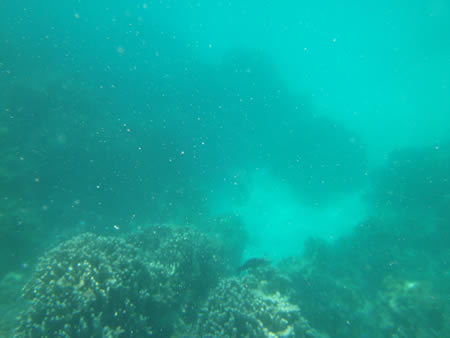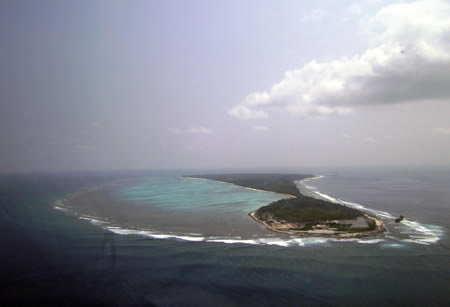印度西南海岸拉克地夫海域(Laccadive Sea)的拉克沙群島(Lakshadweep)首次記錄到珊瑚產卵,該現象在某些地區被稱為「礁岩的繁殖」(sex-on-the-reef)。
珊瑚產卵是珊瑚的有性生殖行為,通常每年固定發生在某個月圓之夜。珊瑚會釋放大量五顏六色的卵子和精子至水中,而後這些精卵將上升至海面,形成彩色鮮明的漂浮物。
印度野生物信託基金會(Wildlife Trust of India)海洋生物學家S. Subburaman與中央海洋漁業研究所(Central Marine Fisheries and Research Institute, CMFRI)團隊在3月下旬首次發現該漂浮物。
Subburaman的發現獲得了中央海洋漁業研究所研究員Jasmine與R. Srinath博士的支持,確認其為珊瑚產卵。
環境研究者Abdul Raheem和Sayeed Ali博士認為該發現顯示,拉克沙群島的珊瑚正在從2010聖嬰現象(El Niño)暖水期的衝擊下復原。
拉克沙群島的首席野生動物巡守員Thirunavukarasu表示該現象表示,拉克沙群島的珊瑚礁是處於一個健康的狀態,這對印度唯一的環礁來說是個好消息。
在珊瑚產卵過程中,卵子會受精並形成珊瑚幼蟲。幼蟲慧在水中漂流,直到牠們找到合適的基質,固著下來,形成自己的群落,成長茁壯。

在澳洲大堡礁(the Great Barrier Reef),珊瑚產卵是一個著名旅遊賣點,它通常發生在11或12月滿月後的數天內。在馬爾地夫(Maldives),珊瑚產卵將於1月底至3月初之間發生。
英國紐卡斯爾大學教授Alasdair Edwards博士表示,「我們預估珊瑚產卵的時間是在今年3月或4月滿月的一個星期後(3月27日或4月25日)。同時,該事件亦顯示,珊瑚也會在白天產卵,不一定是一般認為的晚上。」
調查發現,珊瑚幼蟲在阿格蒂島(Agatti Island)、班加拉姆島(Bangaram)、辛納卡拉島(Thinakara)及卡瓦拉蒂島(Kavarrati)等四個島嶼附近都有形成漂浮物。在該現象獲得解釋前,當地一些居民表示,他們以為那是油汙。
印度野生物信託基金會資深顧問B.C. Choudhury博士表示,「該發現在一個充斥珊瑚白化、珊瑚礁遭到破壞、全球暖化、海平面上升等等珊瑚生存負面消息的時間點出現。它是一個壯觀的現象,拉克沙群島科學家們真的很幸運得以目睹。」
珊瑚通常在暖水時節,以及退潮的時間產卵。Choudhury表示,不同種珊瑚產卵的時間點和模式都不相同,我們仍需要更多的研究才能清楚了解該現象。
Coral spawning, locally called "sex-on-the-reef," has been recorded for the first time along India's southwest coast in the waters around Lakshadweep, a group of islands in the Laccadive Sea.
An annual occurrance normally observed after a full moon night, coral spawning is the sexual reproduction of corals. The phenomenon involves the mass collective expulsion of colorful eggs and sperm clouds into the water that rise to the surface, creating a colorful slick.
The slick was first observed by Wildlife Trust of India marine biologist S. Subburaman last week, and also by the Central Marine Fisheries and Research Institute team.
With the support of CMFRI scientists Dr. Jasmine and R. Srinath, Subburaman examined the samples and confirmed that they were coral spawn.
Environment wardens Abdul Raheem and Dr. Sayeed Ali said this finding shows that Lakshadweep's corals are recovering from the stress they experienced after the 2010 El Niño warm water period.
Lakshadweep's Chief Wildlife Warden Thirunavukarasu said the observation means that the Lakshadweep coral reef is in a healthy state, great news for India's only coral atolls.
During spawning, the eggs are fertilized and form larvae. The larvae then float off till they find suitable substrates, settle and form their own colonies, helping corals thrive.
Coral spawning is a big tourist attraction on the Great Barrier Reef in Australia, where it generally happens soon after the full moon in November or December.
In the Maldives, spawning has been determined to take place between the end of January and the beginning of March.
Dr. Alasdair Edwards, professor at UK's Newcastle University, said, "We expect corals to spawn a week after full moon nights in March (27th for this year) or April (25th for this year)," he said. "This event also shows that corals spawn in day as well, though not as commonly as at night."
A survey showed that the coral larvae were seen forming slick-like layers around four islands – Agatti Island, Bangaram, Thinakara, and Kavarrati. When questioned regarding the phenomenon, some local islanders said they had presumed it to be oil spills.
Dr. B.C. Choudhury, senior advisor for Wildlife Trust of India, said, "This comes at a time when a lot of pessimism surrounds the state of our corals, with talk of them getting bleached, their habitats being destroyed, global warming, sea levels rising and so on. It is really a magnificent sight, and the team of scientists at Lakshadweep was really fortunate to witness it."
Coral spawning normally happens when the water is warm, and when the tide is changing from high to low. "Different species spawn at different times and follow different patterns," said Dr. Choudhury. "Much more research needs to be done to understand the process clearly."
※ 全文及圖片詳見:ENS






